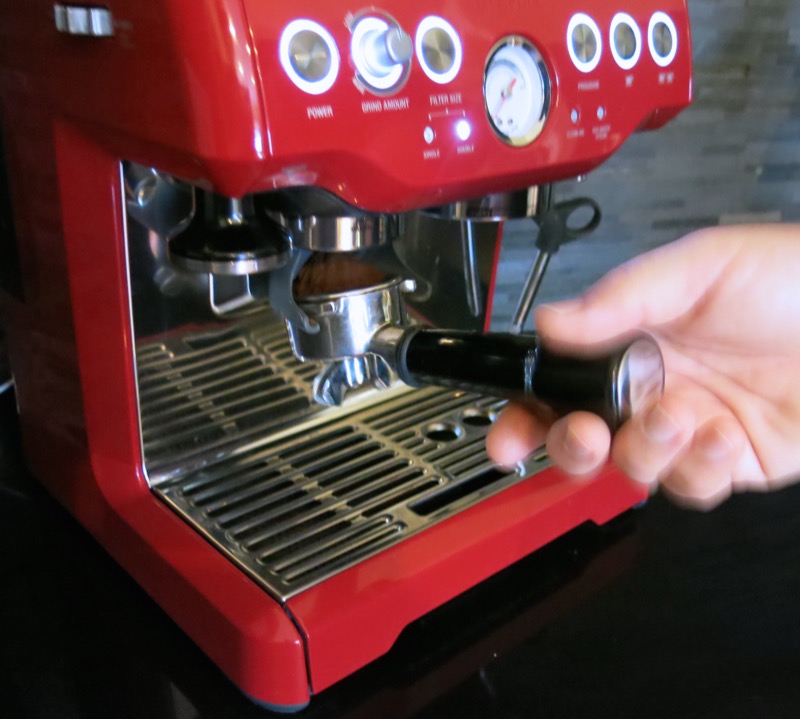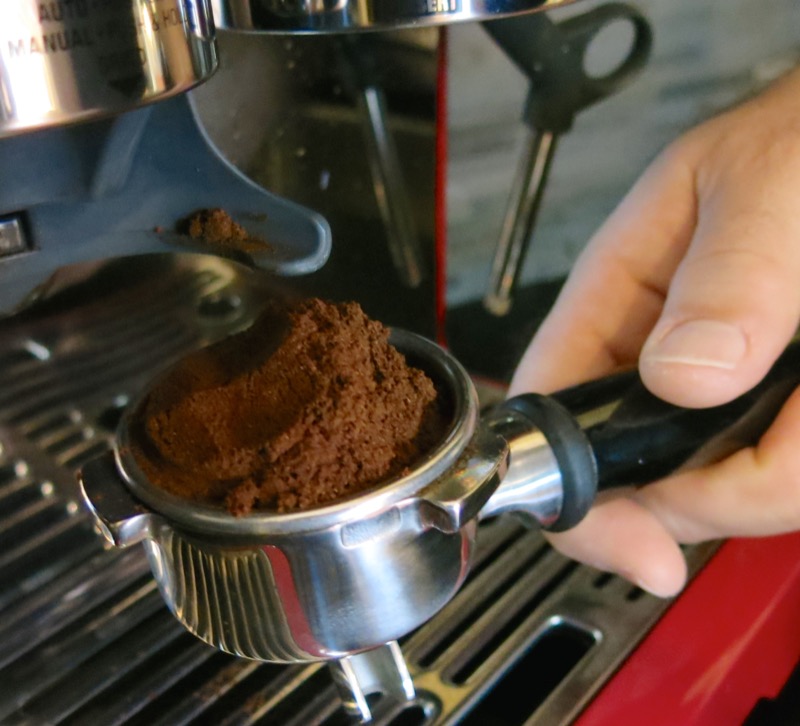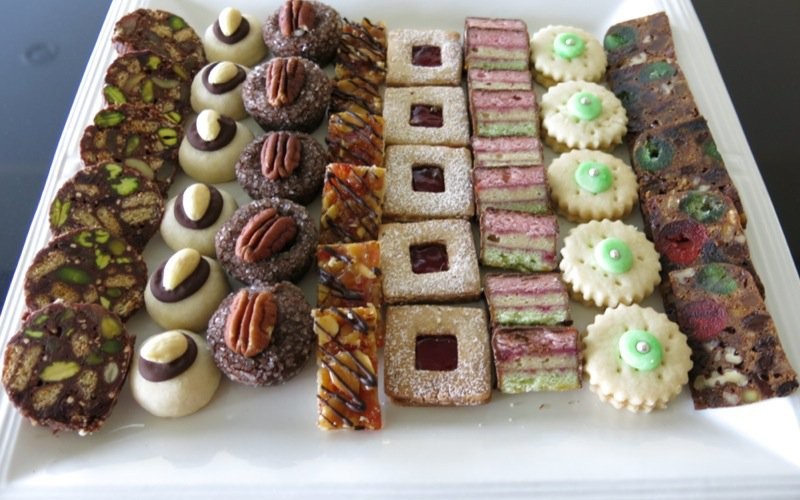Breville Barista Express: Barista Vanja’s Favourites!

It’s getting to look a lot like Christmas at our house and our Breville Barista Express in Cranberry is a very decorative addition this year. Oh, we truly love it. This is the third post in my series of four posts for the company and for those of you in need of a machine and doing your research on which machine is best for you, as well as those of you who just love a great cup of espresso. Tuck this series under your hat until your machine conks out like ours just did last summer.

First post shared why we chose this machine, second focused on the specific features and functions we love, and this one will focus on Vanja’s prowess as a Barista!

Seriously! Look at the above masterpiece made by my Serbo Charger for me! He now considers himself a naive artist in the purist sense.

And the crema! Swoon!
Vanja’s favourite espresso beans, grind, and how he makes himself his morning espresso as well as how he makes me what I consider a perfect cappuccino in our own home with step by step instructions. Grab your own favourite brew, sit back and enjoy the read!
Breville Barista Express: Background Information
To make a great cup of espresso, you need to consider each of the following components which are all built into the Breville Barista Express!
- Bean Selection: “must be fresh, not over roasted and not oily.”
- Amount of Coffee or Size of Dose: “to achieve a consistent and balanced espresso, the dose must be between 19 and 22 grams”
- Water Temperature: “precise temperature control is extremely important in delivering the optimum flavor of espresso”
- Water Pressure: “… a gradual increase of water pressure at the start of extraction [is important to avoid] “channeling” which means water will pass between the tamped coffee and the wall of the basket [resulting] in bitter, over extracted flavors…. maximum flavor potential is achieved when espresso is extracted at roughly 9 bars of pressure.”
- Steam Pressure: “… enough steam pressure [must be reached] to create micro-foam. Micro-foam is made up of thousands of tiny bubbles of textured milk that entrap the oils of the espresso and create a sweet, balanced espresso flavor.”
Committed to supporting and education its clients, Breville has prepared the best site I have seen to understand each of these components and how, together, they affect and create the experience you are looking for. Who knew? Do you really have to be a chemist just to make a cup of morning espresso? Heck no! That is the point. You can get into the nerdy realm, and all that is there within these education modules. At the same time, the simple, straight forward manner with which the machine is able to make it easy does make all of the difference. Vanja does caution: “There is a learning curve. If you love your espresso, it is a fun learning curve.” If you aren’t all that into it, like me, it is fascinating, at the very least. And, not frustrating, either, due to the support provided right here.
Breville Barista Express: Vanja’s Favourite Beans and Why

Vanja really likes the Lavazza blend above, left due to its well balance flavour and pure espresso taste. The beans are fresh, not over roasted, or oily. He finds some beans to be oily or greasy which creates a bitter taste. Eager to test the new machine when it first arrived, he picked up 200g of fresh beans from Starbucks and was surprised to find they were over roasted via the aroma, greasy or oily as shiny when opened and “oily to touch”, then produced bitter tasting coffee. He is about to try the brand to the right as that was his usual preference before he could grind his own beans. Everyone’s experience and preference will be very personal. This is his.
Breville Barista Express: Vanja’s Favourite Grind and Why

Forget about getting a great cup of espresso if you don’t start with great beans. Now, the grind.



As dose affects the strength and body of the espresso and temperature and pressure of water affects the flavour, the grind settings Vanja uses after testing them that produce the best for him are:
- amount of grind at the noon position
- grind size setting at 2 for his signature double espresso


As the ground beans fall into the portafilter, Vanja shakes it so they settle into it and don’t overflow; without the gentle “shake” during the grinding, a high cone will form inside of the portafilter which lends itself to toppling over.

Look at the beautiful grind. The aroma is intoxicating: so cliché and so fitting.
Breville Barista Express: Vanja’s Morning Espresso with Step by Step Instructions
“Too much pressure can lead to bitter flavors. Too little pressure results in a taste that is grassy and under developed.” Vanja has told me over and over: “It’s all about trial and error. But, be consistent in your practice. You know what you like, you work to acquire it as you learn to understand the machine, but the support on the Breville site is extraordinary and it helped a great deal.”
Making Espresso Step One: Tamping


Tamping is important as it compresses the grounds so the water runs through them steadily and evenly to extract the most flavour. When you tamp it the edge of the tamper should be inline with the edge of the portafilter, as in the above right photo. Tamping is like anything else: trial and error. If you don’t tamp enough, water runs through the sides of the portafilter without extracting enough flavour and the water pressure gauge won’t hit the pressure needed for that desired sweet spot. If you over tamp, the water flow is irregular as there is too much resistance for it, so there is no consistent steam, it drips slowly and the gauge goes to the far right; flavours are bitter and there is no crema. In both cases, there is no crema.

Make sure there are no loose grounds around the rim.
Making Espresso Step Two: Warming the Cup

Warm the cup with a single shot dose of hot water.
Making Espresso Step Three: Extracting the Espresso


The double light is on, left, as the amount of grounds selected earlier was for a double shot. If you just press the button, above right, a preprogrammed double shot time frame of about 20 seconds will engage which stops automatically; if you press and hold for an extra second, the extraction process will continue until manually stopped. Vanja does this because he prefers a longer double shot.


The espresso streams into the cup; the stream turns into a crema colour near the end.

Watch the pressure gauge, above. The dark grey area where the needle is at is within the correct pressure for a good espresso as “too much pressure can lead to bitter flavors. Too little pressure results in a taste that is grassy and under developed.” It all relates back to the grind, the tamp and the freshness of the beans. Vanja likes it to reach one notch over to the right, which this did, but tough to catch on camera within the time frame.




Another sign of properly packed grinds is the release from the portafilter in one compact puck shaped disc with minimum residue remaining in the filter.

Voilà! Vanja’s perfect morning double espresso.
Breville Barista Express: Valerie’s Cappuccino with Step by Step Instructions

Look at that masterpiece. It spells L-O-V-E to me! Vanja even surprised himself when he drew this cup of milky comfort for me. Let’s start at the beginning!
Making Cappuccino Step Four: Steaming and Frothing the Milk

The cup is bigger. We have completed steps one to three and have a double shot of espresso in the Lavazza cup, above.


On the right hand side of the machine, the vent is set on steam. When the light above the portafilter blinks, it is heating and when the light remains on, the water has turned into steam and is ready to use in the milk jug.

Don’t just depend upon the light. Check the vent to ensure steam is actually escaping from it, then turn the steam knob to off. Place vent into milk jug on a slight angle and re-engage steam.

Hold it at one angle. Milk will start to circulate inside the jug. The hand holding the jug from the outside will learn to feel the correct temperature when ready, as it will be extremely hot to touch on the outside. At the same time, the milk inside should increase by about 50% and acquire a glazed painterly quality.


Foam is made by air bubbles and after we were done, Vanja knocked the jug on the counter to release the air from the above bubbles to achieve the thick foam that is desired and visible in the finished cup.
Making Cappuccino Step Four: Cleaning the Vent and Pouring


Cleaning the end of the steam vent when it is still hot is a very important next step to avoid a milk scum from accumulating on it; then pour the creamy velvety goodness over the black rich brew.

Seriously?


When did you learn how to make a leaf, Vanja? “I didn’t! This is my first one!” I say him pull back, when the foam arrived and layer it on top of the milk.

You know what that means, don’t you? Of course, I will expect it like this from now on. And what about a heart? And…. Oh, MY! It is so delicious
Breville Barista Express: Breville’s Own Barista Academy
Thus, from the premise that each of you lack the basic knowledge I lack about espresso machines, the above step by step instructions are provided There is so much information “out there” for the expert. This article is not that. This is information for “we common folk” who love a great cup of home brew, espresso, cappuccino, latté, etc. and want to be able to perk off happily on a busy work day, or luxuriate in the opportunity at home on a leisurely weekend morning. And the naive art expressed on the top of the cappuccino aligns with that thinking. I find the imperfection in the design most compelling of all.
Breville has a website designed specifically to support all Breville Barista Express owners. It is a must visit site. The design alone is worthy a minute.
So, where are you at? Is this machine for you? Do you have it already? Buying it? Have another one? Inquiring minds always want to know! Please chime in!
Breville Barista Express Series



- September Breville Barista Express Series: Why the Barista Breville Express?
- October Breville Barista Express Series: Features and Functions
- November Breville Barista Express Series: Making Espresso, Cappuccino, and Latte and Tips
- December Breville Barista Express Series: What We Have Learned
Why the Barista Breville Express?
First, the appearance drew Vanja’s interest, but was not the
- Overall bang for your buck at the mid-range price point
- it is the highest rated machine with all the features on the “want list” and the appearance was appealing
- over 873 reviews on Amazon with 75% a 5 star rating
- Built in Conical Burr Grinder: Burr grinders are far superior to blades, result in a consistent grind and offer a marked improvement in flavor.
- Design: Commercial-like and very professional looking in appearance.
- Features:
- the amount of grind is controlled and adjustable
- includes a hot water dispenser for making tea or Americano
- the heater has 1600W thermocoil: integrated stainless steel water coil accurately controls water temperature and electronic PID temperature control for increased temperature stability which is important as the Francis Francis never seemed to get hot enough to make a latte
- Colour: Cranberry Red!









What is the grind number for espresso coffee
I have breville70xl
HI Fawaz,
Vanja’s favourite grind number is 2 for the espresso beans he uses and the flavour he prefers.
🙂
If you read the information in the series of posts, it may help you to know how to find your own sweet spot!
Sincerely,
Valerie
I have been struggling with trying to find out what I am doing wrong when I make my espresso. After reading this, I think my main problem is tamping. I think I have not been tamping it down enough since my shots have been coming out watery. But now I know that I should tamp it down a little more.
Thanks.
Great!
Try it and let us know if it makes a difference! What kind of a machine do you have, Ana?
🙂
V
I have a little DeLonghi EC 155. It’s the perfect size for me right now, but at some point, I would like to upgrade. I started tamping down my grounds more and it seems to be making better espresso!
Ana!!
YEA!!!
Happy Happy 2017!
🙂
Valerie
Just got the Breville Express for Christmas. How do I know if I have 22 grams of coffee after grinding? Am I supposed dump it out of the puck weigh it and put it back in?
Yup-at first. Eventually, you will get the feel of it once you actually go through this process a few times!
Don’t you LOVE it?
🙂
V
HI! Great tipa! Thank you so much. Ill try them out and let you know. I mighty have some questions too.
Looking forward to hearing back from you.
🙂
I look forward to hearing back from you!
🙂
Is there a limit of cup of coffee can make this machine? Or this is can be 20 cups per day for this machine? Thank you for answering.
HI Dan,
I have asked my husband to respond, and he is currently away. But you can make one cup at a time as many cups a day as you want. You just need to watch the water level and replace the beans for grinding, as needed. The machine will indicate the need to do both for you. WE LOVE IT! 🙂
Valerie
How does it let you know you are out of water? I fink this is the only feature missing. I’ve been in the middle of a shot and it just stops . It was out of water
HI Sherri,
That’s right – but you can easily see the water tank. That’s never happened to us as we just fill it up when it’s low. A little common sense seems to help. HAHA! 🙂 Valerie
Thanks for sharing this post. We just got the machine so testing out first thing in the morning… fingers crossed it turns out well!
How did it go, Natalia!
Inquiring minds want to know!
🙂
Valerie
I have a question on water. Breville recommends filtered water – but which is best – bottled filtered water or tap water put through a filter such as Brita? I love the tips here – I finally got a good shot using the above suggestions. Thanks
HI Marie
I just asked my husband and our machine has a filter in the tank so he maintains that filter, replacing it regularly and just uses tap water – getting excellent results. Our machine is now 3 years old without built-in sediment. However, any kind of double filtering system could only be better, in my humble opinion. Sure hope this helps.
🙂
Valerie
Thanks for the reply. It does help as I have found that the cost of buying filtered water can add up. If your machine is still running well after three years I would consider that a good endorsement.
Great!